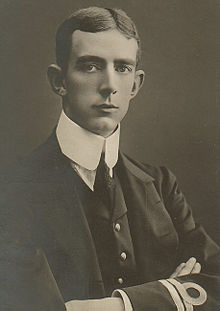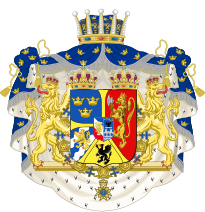Prince Wilhelm, Duke of Södermanland
| Prince Wilhelm | |||||
|---|---|---|---|---|---|
| Duke of Södermanland | |||||
 The Duke of Södermanland (1911) | |||||
| Born | 17 June 1884 Tullgarn Palace, Trosa, Sweden | ||||
| Died | 5 June 1965 (aged 80) Stenhammar Palace, Sweden | ||||
| Spouse | |||||
| Issue | Lennart Bernadotte | ||||
| |||||
| House | Bernadotte | ||||
| Father | Gustaf V of Sweden | ||||
| Mother | Victoria of Baden | ||||
Prince Wilhelm of Sweden, Duke of Södermanland (Carl Wilhelm Ludvig; 17 June 1884 – 5 June 1965) was a Swedish and Norwegian prince. He authored many books (primarily in Swedish) as Prins Wilhelm.
Personal life

Wilhelm was born at Tullgarn Palace, the second son of King Gustaf V of Sweden and his wife Victoria of Baden. [1]
Marriage and divorce
On 3 May 1908, in Tsarskoye Selo, Wilhelm married Grand Duchess Maria Pavlovna of Russia, a daughter of Grand Duke Paul Alexandrovich of Russia by his first wife Princess Alexandra of Greece and Denmark. The bride was a cousin of the reigning Russian tsar, Nicholas II. The couple had one son: Lennart (1909–2004).
The marriage was unhappy. Their son, Lennart, later wrote an autobiography in which he revealed several details of the Swedish royal family. The autobiography tells of how Maria, like her aunt and namesake Grand Duchess Maria Alexandrovna, Duchess of Saxe-Coburg and Gotha, felt that she had married beneath herself in marrying a younger son of the King of Sweden, and this caused problems of ego between the couple. Maria insisted that the servants address her by her correct style Your Imperial and Royal Highness, to the chagrin of her husband, who was merely a Royal Highness. When apprised of the matter, Wilhelm's father King Gustav V had no choice but to acquiesce with his daughter-in-law's wish, which was perfectly valid in law, and ordered that the imperial style be used invariably for Maria.
Maria sought a divorce because of what she described as the horror she then felt toward the Swedish royal family, due to their unlimited support of their official physician, Axel Munthe, who had accosted her sexually.[2] The divorce was granted in 1914, and Maria returned to Russia.
Later life
Wilhelm had a relationship, which was not publicly known, with Jeanne de Tramcourt which lasted from around 1914 (starting date unknown) until Jeanne's death in 1952. They lived together for more than 30 years on the estate Stenhammar near Flen. This was at a time when cohabitation was very unusual and not officially allowed to occur among royalty. Jeanne de Tramcourt was therefore called his "hostess" at Stenhammar. On 2 January 1952 she died in a car accident in a snowstorm near Stjärnhov in Södermanland, when they were on their way to Stenhammar after visiting Wilhelm's son Lennart. Wilhelm was driving when the accident took place. After this tragedy, he is said never to have recovered.
Career and interests
Wilhelm was a noted photographer and the author of several books written in Swedish under the pen name Prins Wilhelm.[3][4]
In keeping with protocol demanded of royalty in modern democracies, Wilhelm kept studiously away from politics. One of his rare forays into the political sphere happened during the Second World War, following the murder of the Danish playwright and Lutheran pastor Kaj Munk on 4 January 1944. It was alleged, perhaps correctly, that the occupying German forces (specifically the Gestapo) were behind the murder, and the Danish resistance newspaper De frie Danske carried condemnatory reactions from numerous influential Scandinavians. Wilhelm was one of those who condemned the murder.[5]
Death

Wilhelm suffered from emphysema caused by several years of chain smoking and died in his sleep, from a heart attack, in Flen, just 12 days before his 81st birthday.
Honours and awards
He received the following orders and decorations:[6]
National honours
- Knight and Commander of the Seraphim, 17 June 1884
- Knight of the Order of Charles XIII, 17 June 1884
- Commander Grand Cross of the Sword, 17 June 1884
- Commander Grand Cross of the Polar Star, 17 June 1884
- Commander Grand Cross of the Order of Vasa, 16 June 1948[7]
- King Oscar II and Queen Sofia's Golden Wedding Medal
- King Oscar II's Jubilee Commemorative Medal
- Crown Prince Gustaf V and Crown Princess Silver Wedding Medal
- King Gustaf V's Jubilee Commemorative Medal (1928)
- King Gustaf V's Jubilee Commemorative Medal (1948)
Foreign honours
- Norway:
- Grand Cross of St. Olav, with Collar, 17 June 1884
- Knight of the Norwegian Lion, 21 January 1904[8]
- King Haakon VII Freedom Cross
- Belgium: Grand Cordon of the Order of Leopold
- Denmark:[9]
- Knight of the Elephant, 18 December 1907
- King Christian X's Liberty Medal
- Egyptian Royal Family: Collar of the Order of Muhammad Ali
- Ethiopian Imperial Family: Collar of the Order of Solomon
- Finland: Grand Cross of the White Rose
- French Third Republic: Grand Cross of the Legion of Honour
- Italian Royal Family: Knight of the Annunciation, 5 July 1913[10]
- Monaco: Grand Cross of St. Charles, 14 April 1927[11]
- Netherlands: Grand Cross of the Netherlands Lion, 6 July 1901[12]
- Romanian Royal Family: Grand Cross of the Order of Carol I
- Thailand: Knight of the Order of the Royal House of Chakri
- Turkish Imperial Family:
- Order of Osmanieh, 1st Class
- Gold Imtiyaz Medal
- Tunisian Royal Family: Order of the Fundamental Pact
- United Kingdom of Great Britain and Ireland:
- Honorary Knight Grand Cross of the Royal Victorian Order, 15 June 1905[13]
- King George V Coronation Medal
- German Imperial and Royal Family:
- Knight of the Black Eagle
- Grand Cross of the Red Eagle
- Kaiser Wilhelm Memorial Medal
- Baden Grand Ducal Family:
- Knight of the House Order of Fidelity, 1902[14]
- Jubilee Medal for 1902
- Commemorative Medal for the Golden Jubilee of Grand Duke Friedrich I and Grand Duchess Luise
- Russian Imperial Family:
Arms
- Wilhelm's coat of arms as prince of Sweden and Norway, Duke of Södermanland 1884 to 1905
- Wilhelm's coat of arms as prince of Sweden, Duke of Södermanland after 1907
Ancestors
| Ancestors of Prince Wilhelm, Duke of Södermanland | |||||||||||||||||||||||||||||||||||||||||||||||||||||||||||||||||||||||||||||||||||||||||||||||||||||||||||||||||||||||||||||||||||||||||||||||||||||||||||||||||||||||||||||||||||||||||||||||||||||||||||||||||||||||||||||||||||||||||||||||||||||||||||||||||||||||||||||||||||||||||
|---|---|---|---|---|---|---|---|---|---|---|---|---|---|---|---|---|---|---|---|---|---|---|---|---|---|---|---|---|---|---|---|---|---|---|---|---|---|---|---|---|---|---|---|---|---|---|---|---|---|---|---|---|---|---|---|---|---|---|---|---|---|---|---|---|---|---|---|---|---|---|---|---|---|---|---|---|---|---|---|---|---|---|---|---|---|---|---|---|---|---|---|---|---|---|---|---|---|---|---|---|---|---|---|---|---|---|---|---|---|---|---|---|---|---|---|---|---|---|---|---|---|---|---|---|---|---|---|---|---|---|---|---|---|---|---|---|---|---|---|---|---|---|---|---|---|---|---|---|---|---|---|---|---|---|---|---|---|---|---|---|---|---|---|---|---|---|---|---|---|---|---|---|---|---|---|---|---|---|---|---|---|---|---|---|---|---|---|---|---|---|---|---|---|---|---|---|---|---|---|---|---|---|---|---|---|---|---|---|---|---|---|---|---|---|---|---|---|---|---|---|---|---|---|---|---|---|---|---|---|---|---|---|---|---|---|---|---|---|---|---|---|---|---|---|---|---|---|---|---|---|---|---|---|---|---|---|---|---|---|---|---|---|---|---|---|---|---|---|---|---|---|---|---|---|---|---|---|---|---|---|---|
| |||||||||||||||||||||||||||||||||||||||||||||||||||||||||||||||||||||||||||||||||||||||||||||||||||||||||||||||||||||||||||||||||||||||||||||||||||||||||||||||||||||||||||||||||||||||||||||||||||||||||||||||||||||||||||||||||||||||||||||||||||||||||||||||||||||||||||||||||||||||||
References
- ^ "Prince Wilhelm - Sveriges Kungahus". www.kungahuset.se. Retrieved 7 May 2020.
- ^ Lennart Bernadotte in Käre prins, godnatt! ISBN 91-0-041935-4 pp. 155-158
- ^ Amerika från estraden 1928
- ^ Känner du landet 1950
- ^ "KAJ MUNK IN MEMORIAM". De frie Danske (in Danish). January 1944. p. 6. Retrieved 18 November 2014.
Nu er han borte. Myrdet af fire gangstere, en Forbrydelse uden lige. Hvor meningsløst: Ordet dør ikke, fordi man dræber Ordets Forkynder, Aanden knuses ikke af en Revolverkugle. Terror kan aldrig udslette Digterværk, saalidt som den formaar at undertrykke Ideer. Tankens Frihed overvinder selv den væreste Forbrydelse. Kaj Munk blev en Martyr for sit Frihedskrav, men hans skabende Kulturindsats skal leve med stigende Intensitet efter dette. Nordisk Litteratur har Landesorg
- ^ Sveriges statskalender (in Swedish), 1955, p. 6, retrieved 6 January 2018 – via runeberg.org
- ^ Sveriges statskalender (in Swedish), 1955, p. 127, retrieved 6 January 2018 – via runeberg.org
- ^ "The Order of the Norwegian Lion", The Royal House of Norway. Retrieved 10 August 2018.
- ^ Bille-Hansen, A. C.; Holck, Harald, eds. (1963) [1st pub.:1801]. Statshaandbog for Kongeriget Danmark for Aaret 1963 [State Manual of the Kingdom of Denmark for the Year 1963] (PDF). Kongelig Dansk Hof- og Statskalender (in Danish). Copenhagen: J.H. Schultz A.-S. Universitetsbogtrykkeri. p. 18. Retrieved 1 May 2020 – via da:DIS Danmark.
- ^ Italy. Ministero dell'interno (1920). Calendario generale del regno d'Italia. p. 58.
- ^ Journal de Monaco
- ^ "Court Circular". The Times. No. 36500. London. 6 July 1901. p. 12.
- ^ "No. 27807". The London Gazette. 16 June 1905. p. 4251.
- ^ Hof- und Staats-Handbuch des Großherzogtum Baden (1910), "Großherzogliche Orden" p. 41


